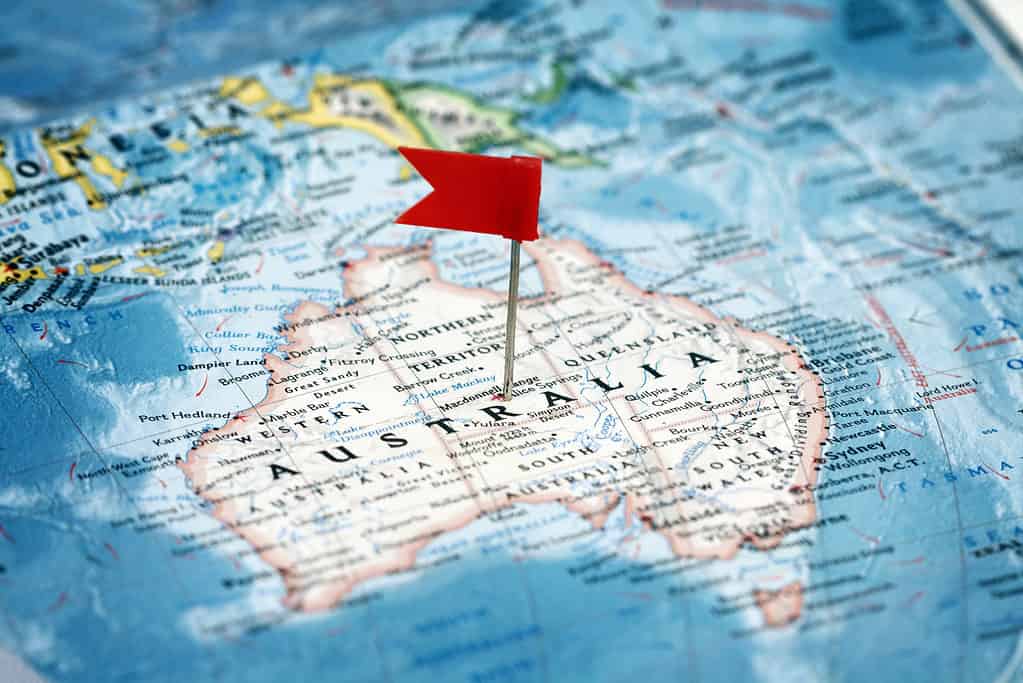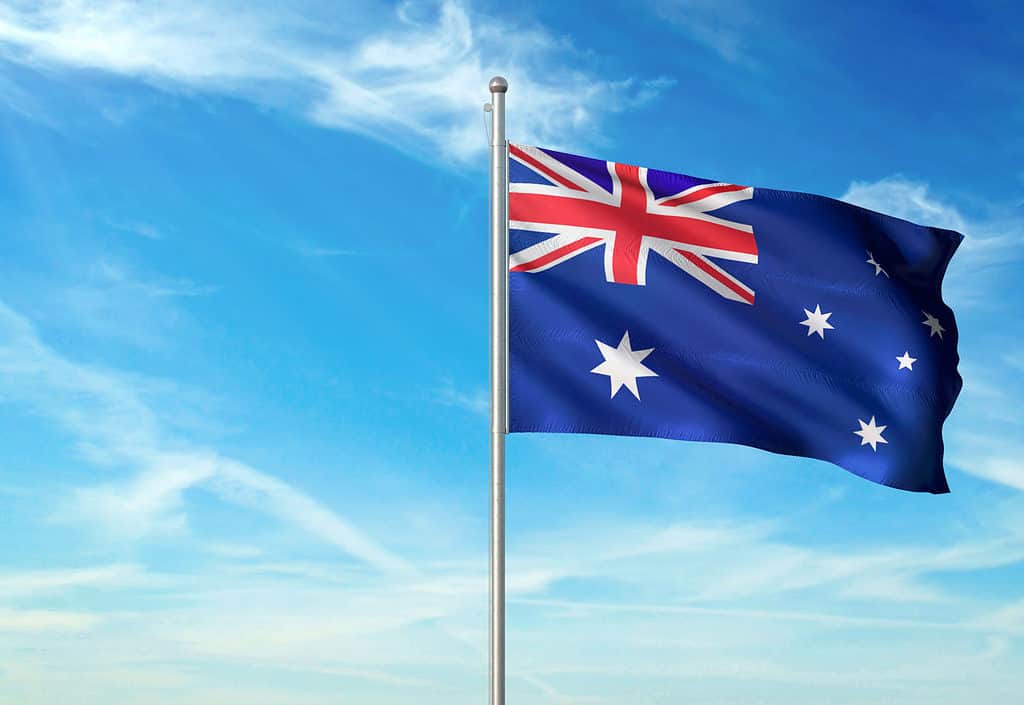One of Australia’s most prominent features is that it doubles as a country and a continent. It is located between the Indian Ocean and the Pacific Ocean and southeast of the Asian continent. Although many assume its capital to be Sydney or Melbourne, Australia’s capital city lies between the two in Canberra. While Australia is an independent country in modern times, it formerly belonged to Britain as a colony. In fact, many aspects of Australian culture pay homage to their mother country, including their national flag and other flags found within the region. Many include the Union Jack canton, and one acknowledges British royalty. Discover what these flags look like and what they symbolize to Australians then and now.
Founding of Australia
Before the British settled in Australia in 1788, many indigenous groups lived within the region, and up to 250 languages were spoken by these groups. Experts have estimated that Australia’s population before British settlement ranges from 300,000 to one million people. New South Wales was a colony that the British founded in Australia, and Britain sent convicts and felons to New South Wales until other areas within the country were established to receive them. It has been approximated that over 162,000 convicts from Britain were sent to these colonies.
In the 1850s, people began to discover gold in Australia. Therefore, many flocked to the region, hoping to become rich. However, in 1854, the Eureka Stockade took place. The Eureka Stockade was a revolt thrown by gold miners in Australia because had become frustrated with Britain’s high taxation. In addition, as many as 50,000 residents of China immigrated to Australia during this time.
In 1901, Australia gained independence from Britain and formed the Commonwealth of Australia. The Commonwealth of Australia included all states and colonies within the country. While Australia extended an invitation to New Zealand and Fiji to join the Federation of Australia, both countries determined that they would stay separate from the new country.
Following World War II and then again after the Vietnam War, Australia saw mass immigration. Asian migration to Australia was most prominent in the 1970s, which aided Australia with their inclusivity of many different people groups. In fact, Australia has an exemplary reputation for equality and very few class differences.

One of Australia’s most prominent features is that it doubles as a country and a continent.
©iStock.com/AlexKosev
Characteristics of Australia
The continent of Australia includes many unique geographic and topographic features. For instance, the Great Barrier Reef includes the largest amount of coral in any singular location on Earth. Furthermore, the reef’s unique plant and animal life attracts tourists from all over. On the other hand, much of Australia’s geography is comprised of many deserts and isolated wastelands. Cities mainly lie along the coast of the country, as the deserts are unpleasant to inhabit.
Climate in Australia is extremely dry and arid. In fact, Australia is the second-driest continent in the world, following behind Antarctica. Over 30% of Australia receives less than 10 inches of annual precipitation, and only a little over 10% sees more than 40 inches of rainfall every year. In the innermost parts of Australia, temperatures frequently reach over 100ºF during the summer. Australia’s climate also changes often due to varying air pressure systems over the Pacific Ocean, which are caused by differences in ocean temperatures. Furthermore, annual temperature differences in the Indian Ocean can also affect the country’s climate. These differences can reduce or increase rainfall in Australia, depending on the year.
Finally, Australia is well-known across the globe for its biodiversity, especially because much of its plant and animal life cannot be found anywhere else in the world. The eucalyptus tree contains over 400 unique species, which have adapted to many climates, including rainforests and deserts. Acacia is also prominent in the country, and within Australia lie approximately 700 species of this plant. Furthermore, animals like kangaroos, koalas, and wallabies are included in the 200,000 to 300,000 animal species that live in Australia. Of these 200,000 to 300,000 species, 2,000 are fish, 550 are birds, and 680 are reptiles.

Koalas and eucalyptus trees are examples of Australia’s unique biodiversity.
©iStock.com/Maridav
History and Symbolism of the Flag of Australia
The first flag of Australia was designed for the colony of Australia before it became independent from Britain. It was a white flag divided by a red, off-centered cross containing four white stars. It featured the British flag as its canton and served as the National Colonial Flag of Australia from 1823 to 1831.
The Australian Federation Flag was designed next and took the place of the National Colonial Flag of Australia in 1831. This flag had the same white rectangle background, but its cross was centered and blue. The cross contained five stars as opposed to the original four. The British flag remained as the canton of the Australian Federation Flag.
The official and final flag of Australia was designed in 1901 and adopted in 1908. The current flag features a dark blue background with the British flag canton. The Union Jack canton represents the history of British settlement in Australia. It also contains six white stars that make the shape of a constellation that can be seen in the night sky due to the country’s geographic location. Five of the six stars have seven points. The white stars’ seven points signify the unity between the states and territories within Australia. The smallest star seen on the flag of Australia has five points.

The flag of Australia features a dark blue background with the British flag canton and six white stars.
©iStock.com/Oleksii Liskonih
Other Australian Flags
The flag of the Australasian Anti-Transportation League was designed in 1849 and appears much like the flag of Australia that people recognize today. They are practically identical except that the stars in the Australasian Anti-Transportation League Flag appear white, rather than yellow, and are placed in different locations on the flag.
Van Dieman’s Land Ensign was a flag created in 1850 and served as an unofficial merchant flag. The flag represented the colony of present-day Tasmania. It had several blue and white horizontal stripes interrupted by a red cross. The British flag served as the canton on this flag, as it had on all other Australian flag designs.
In 1854, a group of Australian gold miners staged a revolution, which led to the battle of Eureka Stockdale. They created a flag for themselves, which had a blue background, a centered white cross, and five eight-pointed white stars that lie at the edges and center of the cross. In modern times, this flag symbolizes protest.
The Australian Aboriginal Flag, which was designed in 1971, appears much like the flag of Japan, but it includes other aspects that help to differentiate the two. The Australian Aboriginal Flag has a simple design; the uppermost portion is black, and the bottommost portion is red. These two rectangles are divided horizontally. In the very center sits a large yellow circle. The black portion signifies Aboriginal people, while the red section represents their spiritual connection to the land and the Earth itself. The yellow circle acts as the sun, shining life onto others.
In 1992, the Torres Strait Islanders created a flag for themselves. The flag has horizontal green lines that border the top and bottom, and along the green lines run black lines. In the middle of these lines lies a large blue rectangle. The image in the center of the flag depicts a white dhari headdress that covers a white star comprised of five points.
Finally, Australia has numerous flags to represent the queen or king of Britain, governors of the states within Australia, mainland and external territories, and the military. For example, the Queen’s personal Australian flag features six Australian state badges within it. In the center lies a golden yellow star with seven points. A dark blue circle sits in the center of the star with a yellow letter E to represent Elizabeth. After Queen Elizabeth’s death, the blue circle containing the letter E was to be replaced by a blue circle containing the letters C and R. The new design was to represent King Charles of Britain.
Click here to learn about every single flag in the world!
Up Next
- The Flag of Equatorial Guinea: History, Meaning, and Symbolism
- 8 Spiders in Australia
- 29 Different Countries with Red, White, and Blue Flags
The photo featured at the top of this post is © iStock.com/Ardani Saputro
Sources
- Flagmakers, Available here: https://flagmakers.co.uk/flag-history/australia/
- Australian Government, Available here: https://www.pmc.gov.au/government/australian-national-flag#:~:text=It%20has%20seven%20points%20representing,on%20the%20flag%20in%20white
- Insider Guides, Available here: https://insiderguides.com.au/brief-guide-history-australia/
- W.D.L. Ride, Available here: https://www.britannica.com/place/Australia
FAQs (Frequently Asked Questions)
When was Australia founded?
The British began to settle in Australia in 1788, and Australia gained independence in 1901.
What are examples of prominent Australian cities?
Some well-known Australian cities are Sydney, Melbourne, and Canberra.
When was the Australian flag introduced?
There have been many versions of the Australian flag over several decades. However, the current Australian flag was designed in 1901 and adopted in 1908.
Thank you for reading! Have some feedback for us? Contact the AZ Animals editorial team.






